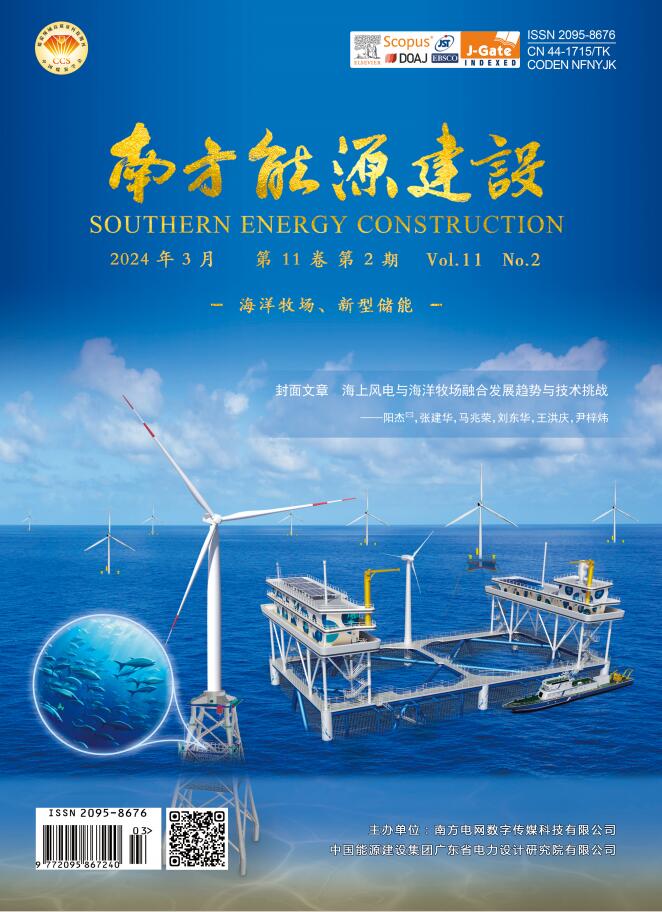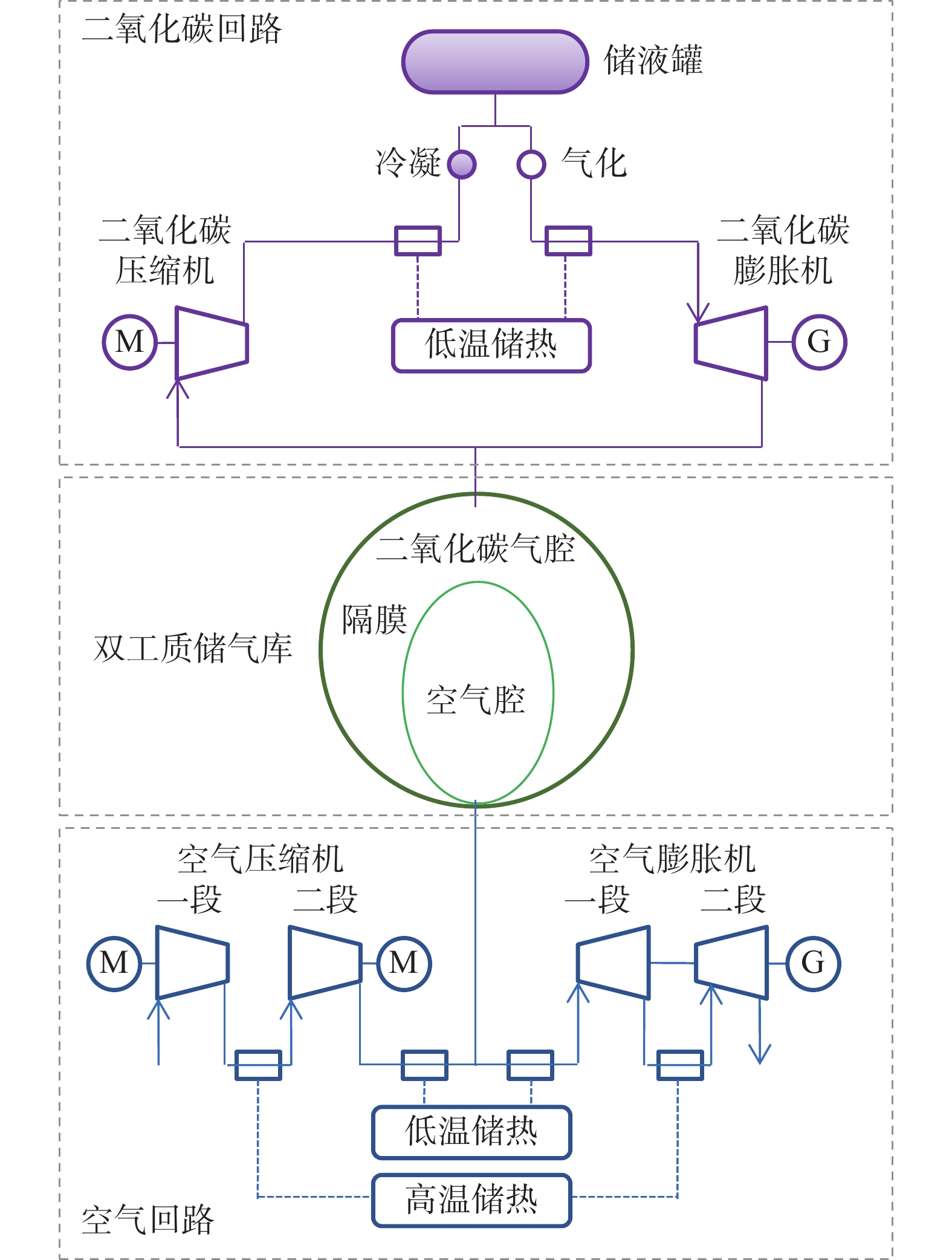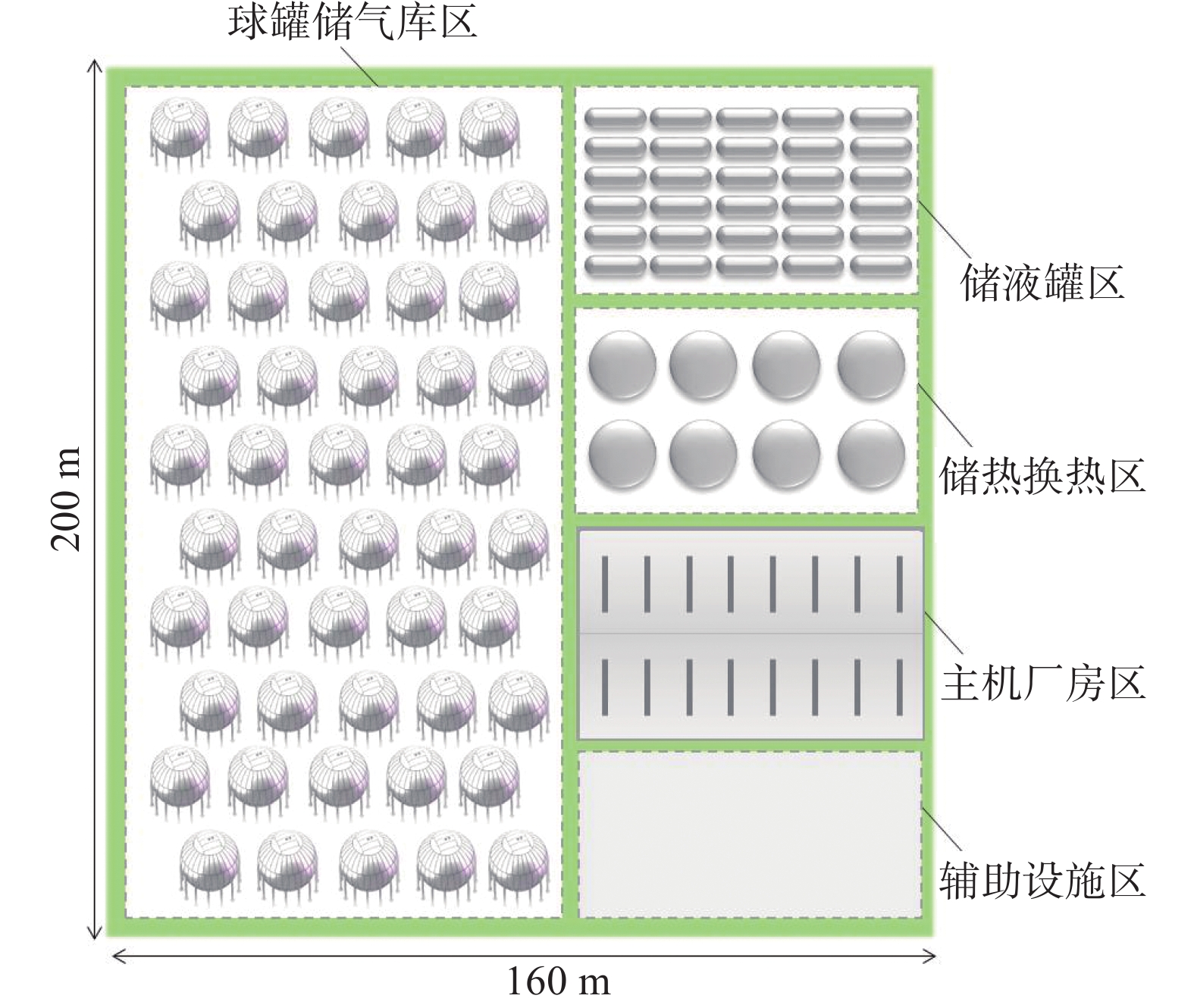-
压缩空气储能是一种历史悠久的物理储能方式,1949年,Stal Laval申请了地下洞穴储气的压缩空气储能系统专利,并在上个世纪,德国Huntorf和美国McIntosh两座商业化压缩空气储能电站先后投运[1-2]。当前,我国在压缩空气储能领域处于世界领先水平,成功实现了非补燃压缩空气储能技术路线,建成毕节、肥城、金坛、张北等示范电站[2-5],并且正在建设300 MW级大容量压缩空气储能电站[6]。由于压缩空气储能具有安全、环保、高效、长时以及寿命长等优点,被列入国家和地方相关规划,作为重要的新型储能技术之一。压缩空气储能电站的储气库容很大并且储气压力很高,技术成熟且经济可行的储气方式主要还是传统的地下盐穴储气库,人工硐室尚处于示范验证阶段,而高压管道储气成本偏高[7-9]。优质的盐穴资源分布区域较为稀缺[10-11],导致压缩空气储能电站发展有很大的局限性。
压缩二氧化碳储能于2022年正式进入储能行业的视野,包括意大利Energy Dome和我国的东方汽轮机公司的示范项目相继投运,利用二氧化碳的气液相变过程实现储能[12-13]。相比压缩空气储能,压缩二氧化碳储能不需要地下储气库储气,而是采用常压的柔性气膜储气仓来储存二氧化碳气体以及采用高压液体储罐储存液体二氧化碳。表面上看来,压缩二氧化碳储能电站的选址不依赖地理资源条件,但实际上还是存在一些问题,即巨大的气膜仓,其占地面积过大,单位容量占地可达400 m2/MWh以上,较难满足建设用地指标有限制的地区。例如:《甘肃省风力发电项目建设用地标准》规定,新能源场站配套储能电站按照150~200 m2/MWh确定用地指标,单独储能电站用地以200 MW规模为例,用地指标不应超过130 m2/MWh。
我国是世界第一工业制造大国,各类工业园区约有2万家,其中省级及以上工业园区有2500余家,工业园区碳排放占到全国碳排放总量的31%[14]。工业发达地区,特别是东部沿海地区,工业园区的储能需求量非常大,储能的政策激励力度也大,包括拉大峰谷电价差、给予储能项目补贴、支持新型储能技术示范等。由于绝大多数工业园区没有地下盐穴或其他地下储气库资源,往往也不适合开发人工硐室[15-16],用地指标也比较紧张,所以气体压缩储能,包括压缩空气或压缩二氧化碳储能,应用于工业园区需要发展符合用地指标和规范标准,且经济可行的地面储气库方案。
基于以上考虑,文章提出一种双工质气体压缩储能系统,试图解决气体压缩储能的选址灵活性问题,以便在众多的工业园区或其他适用的区域发展气体压缩储能。
-
双工质气体压缩储能系统将压缩空气储能与压缩二氧化碳储能技术相结合,并共用储气系统。图1为双工质气体压缩储能系统的总体工艺流程,包括空气回路、二氧化碳回路和双工质储气库,前两者均为常规的气体压缩储能回路设计,后者的双工质储气库为特殊设计的承压容器,由柔性隔膜分隔成空气腔和二氧化碳气腔,隔膜可自由缩放,不受张力作用,从而保持空气腔和二氧化碳气腔压力相等并可调节容积。系统工作压力的最低值为大气压力,最高压力为液态二氧化碳储液罐的压力,中间的压力为双工质储气库的压力。
双工质气体压缩储能系统的运行过程如下:
初始时系统处于能量放空状态,双工质储气库空气腔处于无气状态且二氧化碳气腔充满给定储气压力的二氧化碳气体。
储能阶段包括同时进行的压缩空气储能和二氧化碳液化储能过程:电动机驱动空气压缩机将来自大气中的空气压缩至给定储气压力后送入到空气腔,期间利用空气换热器回收空气压缩热并储存;与此同时,电动机驱动二氧化碳压缩机将二氧化碳从二氧化碳气腔抽出并压缩至液化压力,期间利用二氧化碳换热器回收气体二氧化碳压缩热并储存,再将二氧化碳冷凝液化后输送至储液罐。储能过程中,双工质储气库始终维持给定储气压力。系统储满能量时,空气腔充满压缩空气,二氧化碳气腔全部放空。
释能阶段包括同时进行的液体二氧化碳气化膨胀释能和压缩空气膨胀释能过程:高压液体二氧化碳从储液罐输出并经蒸发器气化和二氧化碳回热器加热后输入二氧化碳膨胀机发电,膨胀降压至给定储气压力后的二氧化碳输入二氧化碳气腔;空气腔输出压缩空气经空气回热器加热后在空气膨胀机内膨胀发电,膨胀至大气压后排放至大气环境。液体二氧化碳气化热量包括来自系统和外部的余热,二氧化碳和空气回热热量来自系统储热装置。释能过程中,双工质储气库始终维持给定储气压力。系统能量完全释放时,二氧化碳气腔充满压缩二氧化碳气体,空气腔全部放空。
双工质气体压缩储能系统储气库恒压运行,类似于恒压式压缩空气储能系统[17-18]。双工质气体压缩储能系统运行过程储气库压力恒定,储气库可以满充满放,高压二氧化碳在常温下即可液化,液体二氧化碳密度大,储液罐体积远小于储气库。因此,双工质气体压缩储能系统实现了压缩空气储能与压缩二氧化碳储能的优势互补。
-
双工质气体压缩储能系统可集成现有成熟设备,构建百兆瓦级大规模电力储能电站。文章以适合于工业园区配套的100 MW/400 MWh规模的分布式储能电站为例进行分析。
双工质储气库的工作压力选3 MPa(a)。一方面,此压力对于承压容器的选型比较有利,比如:可选用球罐、管道储气库;另一方面,3 MPa(a)压力下二氧化碳的液化温度是−5.55 ℃,在东南沿海地区的气温条件下,可避免二氧化碳气腔中的气体在低温季节发生液化而导致压力失控。
空气回路的布置类似于常规的压缩空气储能系统,并采用两段压缩、两段膨胀方式。第一段压缩机压比约为10,第二段压缩机压比约为3,两段压缩机分别配置一台电动机。第一段膨胀机膨胀比约为3,第二段膨胀机膨胀比约为10,两段膨胀机共同驱动一台发电机。压缩机排气热量用储热方法回收,并用于回热膨胀机进气。第一段压缩机排气热量温度高,可采用熔盐、导热油储热,用于第二段膨胀机进气回热;第二段压缩机排气热量温度低,可采用高压水储热,用于第一段膨胀机进气回热。
二氧化碳回路的布置采用一段压缩、一段膨胀的方式。二氧化碳压缩机配套一台电动机,排气压力约8 MPa(a),二氧化碳压缩机排气热量用储热方法回收,可采用高压水储热,用于膨胀机进气回热。二氧化碳临界点为31 ℃/7.4 MPa(a),二氧化碳的冷凝可通过环境冷却液化,二氧化碳气化可利用工业园区低温余热及系统自身余热。二氧化碳膨胀机排气压力3 MPa(a),驱动一台发电机。
系统的上述参数用于文章初步的热力学计算,实际的工程设计还需要结合厂址条件和运行工况进一步优化工艺流程和参数,使设计性能达到最佳。
-
根据参考文献[19],选取其中较高的设备性能参数,用于双工质气体压缩储能系统的空气回路,同时,补充二氧化碳回路的设备性能参数,见表1,其他次要设备及其能耗对系统影响忽略不计,并假定周边条件可以满足二氧化碳的液化和气化的能量需求,液体二氧化碳按照27 ℃/8 MPa(a)储存。储能过程时长6 h,释能过程时长4 h。按表1参数,运用干空气和二氧化碳物性数据,对系统额定工况下的储能效率、能量密度及其他指标进行计算。
设备性能参数 设备性能参数值 一段空气压缩机等熵效率 0.845 一段空气压缩机机械效率 0.990 一段空气压缩机电动机效率 0.980 二段空气压缩机等熵效率 0.860 二段空气压缩机机械效率 0.990 二段空气压缩机电动机效率 0.980 一段空气膨胀机等熵效率 0.900 一段空气膨胀机机械效率 0.990 二段空气膨胀机等熵效率 0.930 二段空气膨胀机机械效率 0.990 空气膨胀发电机效率 0.980 二氧化碳压缩机等熵效率 0.830 二氧化碳压缩机机械效率 0.980 二氧化碳压缩机电动机效率 0.970 二氧化碳膨胀机等熵效率 0.880 二氧化碳膨胀机机械效率 0.980 二氧化碳膨胀发电机效率 0.970 换热器压损/MPa 0.050 空气高温回热温差/℃ 35 空气低温回热温差/℃ 20 二氧化碳回热温差/℃ 15 Table 1. Performance parameters of the equipments for the energy storage system with binary cycle gas compression
通过热力学分析计算,得到上述双工质气体压缩储能系统额定工况下流量、温度、压力等关键状态参数,以及透平机械做功参数,相关数据列于表2。
额定工况状态参数 状态参数值 空气压缩流量/(Nm3·h−1) 4.39×105 一段空气压缩机进口温度/℃ 20.00 一段空气压缩机进口压力/MPa(a) 0.098 一段空气压缩机出口温度/℃ 340.17 一段空气压缩机出口压力/MPa(a) 1.00 二段空气压缩机进口温度/℃ 35.00 二段空气压缩机进口压力/MPa(a) 0.95 二段空气压缩机出口温度/℃ 181.06 二段空气压缩机出口压力/MPa(a) 3.05 空气压缩电动机功率/MW 76.51 二氧化碳压缩流量/(Nm3·h−1) 5.28×105 二氧化碳压缩机进口温度/℃ 20.00 二氧化碳压缩机进口压力/MPa(a) 3.00 二氧化碳压缩机出口温度/℃ 107.42 二氧化碳压缩机出口压力/MPa(a) 8.10 二氧化碳压缩电动机功率/MW 18.46 储能功率/MW 94.97 储能输入电量/MWh 569.84 空气膨胀流量/(Nm3·h−1) 6.58×105 一段空气膨胀机进口温度/℃ 156.47 一段空气膨胀机进口压力/MPa(a) 3.00 一段空气膨胀机出口温度/℃ 51.97 一段空气膨胀机出口压力/MPa(a) 1.00 二段空气膨胀机进口温度/℃ 305.17 二段空气膨胀机进口压力/MPa(a) 0.95 二段空气膨胀机出口温度/℃ 52.55 二段空气膨胀机出口压力/MPa(a) 0.103 空气膨胀发电机功率/MW 82.76 二氧化碳膨胀流量/(Nm3·h−1) 7.92×105 二氧化碳膨胀机进口温度/℃ 92.42 二氧化碳膨胀机进口压力/MPa(a) 7.90 二氧化碳膨胀机出口温度/℃ 20.23 二氧化碳膨胀机出口压力/MPa(a) 3.00 二氧化碳膨胀发电机功率/MW 17.24 释能功率/MW 100.00 释能输出电量/MWh 400.00 储能效率/% 70.20 二氧化碳用量/t 6.87 储气库容量/m3 9.47×104 储液罐容量/m3 9.15×103 能量密度/(kWh·m−3) 3.85 Table 2. State parameters of rated condition for the energy storage system with binary cycle gas compression
双工质气体压缩储能系统的储能效率为:
$$ \eta=E_{\text {out }} / E_{\text {in }} $$ (1) 式中:
η ——储能效率;
Eout ——释能过程输出电量(kWh);
Ein ——储能过程输入电量(kWh)。
能量密度近似为:
$$ D=E_{\text {out }} /\left(V_{\mathrm{g}}+V_{\mathrm{l}}\right) $$ (2) 式中:
D ——能量密度(kWh/m3);
Vg ——储气库容量(m3);
Vl ——储液罐容量(m3)。
由表2可知,100 MW/400 MWh双工质气体压缩储能系统中,系统的储能效率70.20%,而文献报道压缩空气储能电站设计效率可达70%[20],两者相近。可见,双工质气体压缩储能系统储能效率可以达到压缩空气储能的水平。
双工质气体压缩储能系统的能量密度为3.85 kWh/m3,而压缩二氧化碳储能系统的能量密度约0.1 kWh/m3,其能量密度远高于压缩二氧化碳储能系统。盐穴压缩空气储能系统采用地下储气,能量密度方面不具备可比性。
100 MW/400 MWh双工质气体压缩储能系统的生产区设施布置如图2所示,假定储气库采用钢制球罐,单个球罐容积约2000 m3,直径约15.7 m,按50个球罐布置,储气库区占地面积约18000 m2,再加上储液罐、储热、主机厂房、公用及其他设施,生产区总占地面积约32000 m2。
-
双工质气体压缩储能系统采用地面储气方式,既不依赖盐穴或其他洞穴资源,也不需要建造人工硐室,同时,地面储气库占地面积适中,可确保系统用地指标不超,完全可以进入工业园区布置,贴近工业用户。
系统所使用的空气和二氧化碳工质为自然工质,系统运行过程没有污染物排放,系统压力为中压等级,系统中的设备均为常规工业设备,建设和运行也不涉及特种工艺,完全满足工业园区的安全和环保要求,并且由于地面布置,操作、维护、检测、管理等各项工作均十分便利。系统退役后,所有设备和设施均可拆除,复原厂址,而且储气库、储液罐、透平设备、容器、管道等都具有较高的残值,可回收资金非常可观。
系统除了提供电能以外,还可提供压缩空气、冷量(液体二氧化碳蓄冷)、热量(压缩热)等多联供,满足工业用户的储能需求和电、气、冷、热多类型的用能需求。工业园区能耗高,同时,散热量也高,这就为系统获取低温热量用于二氧化碳气化提供很大的便利。这两方面都十分有利于系统储能效率或综合能效的提高。
工业园区是双工质气体压缩储能最适合的应用场景,100 MW/400 MWh等级的规模适合于服务工业用户的中小型分布式储能电站,也可建设多套系统,组成服务电网侧的大型集中式储能电站或者服务新能源场站的共享式储能电站。
-
以上述100 MW/400 MWh双工质气体压缩储能系统为例,系统中的压缩空气储能机组、压缩二氧化碳储能机组和换热储热装置均可采用现有成熟技术和设备,这些设备再加上配套辅助设施,三部分的单位造价约3000元/kW,总造价约3亿元,其中二氧化碳储液罐造价占比可达20%。对于采用钢制球罐方式的储气库系统,其造价约3亿元,单位造价约3000元/kW。由于各地区征地价格差异很大,长三角地区大多在75万元/hm2~375万元/hm2区间,征地费用约1000万元,所以征地费用对系统总造价影响小。如果不考虑征地费用,系统总造价约6亿元,总的单位造价约6000元/kW(1500元/kWh)。
储气库造价高,在系统总造价中的占比达50%,有必要研发新材料、新工艺和新设计,大幅降低储气库建造成本,同时,进一步通过标准化、批量化建造,系统单价造价有望降低至趋近于大型抽水蓄能电站以及盐穴压缩空气储能电站单位造价水平[20]。
双工质气体压缩储能系统的选址及建造难度低,项目建设周期可控制在2 a以内。作为机械式储能方式,双工质气体压缩储能系统的主设备设计寿命长,系统服役寿期可达到30 a以上。
-
双工质气体压缩储能系统的商业竞争力评估,以传统的抽水蓄能和已实现商业化应用的锂电池,以及处于商业化应用初期的全矾液流电池、盐穴压缩空气储能、压缩二氧化碳储能等大规模长时储能方式,作为比较对象,从安全环保、造价水平、储能效率、使用寿命、建设周期、占地面积等多维度,按照100 MW/400 MWh规模为基准进行评估,见表3。
方式 安全环保 造价水平/[元·(kWh)−1] 储能效率水平/% 使用寿命/a 建设周期/a 占地规模/hm2 抽水蓄能 优 1000 75~85 >30 >5 35.0 锂电池 中 1000 85~90 <15 <1 3.0 全矾液流电池 中 2500 75~80 >20 <1 6.0 盐穴压缩空气储能 优 1000 65~75 >30 2 1.5 压缩二氧化碳储能 优 1200 65~70 >30 2 15.0 双工质气体压缩储能 优 1500 70~75 >30 2 3.5 Table 3. Comparison of the energy storage system with binary cycle gas compression with other energy storage methods for an energy storage scale capacity of 100 MW/400 MWh
在厂址条件合适的情况下,抽水蓄能[21]和盐穴压缩空气储能具有良好的商业竞争力[22]。在用地指标宽松的情况下,压缩二氧化碳储能也具有较好的商业竞争力。这些情况下,双工质气体压缩储能系统不具备商业竞争力的优势。在厂址条件和用地指标都有限制的情况下,比如工业园区储能场景,只能选用锂电池、全矾液流电池或双工质气体压缩储能,相比前两种储能方式,双工质气体压缩储能优势显著,特别是可以运用多联供方式的情况,其储能效率方面也不会逊色。
-
双工质气体压缩储能集成压缩空气储能与压缩二氧化碳储能技术,采用特殊结构的双工质储气库,可以构建基于地面储气库的气体压缩储能系统。相比盐穴压缩空气储能,此系统摆脱了对地理资源的依赖;相比气膜仓储气的压缩二氧化碳储能,此系统占地面积大幅缩减。
基于3 MPa储气压力的钢制球罐储气库,100 MW/400 MWh双工质气体压缩储能系统的储能效率70.20%,生产区占地面积约32000 m2,总投资约6亿元,单位造价约6000元/kW(1500元/kWh),总体技术经济性有望接近于抽水蓄能电站和盐穴压缩空气储能电站水平。
双工质气体压缩储能系统安全环保,选址灵活,占地面积适中,适合于工业园区配套储能,服务于工业用户,并发挥其电、气、冷、热多联供作用,相比电化学储能,具有较好的商业竞争力。
未来随着新能源发电规模不断扩大,储能的需求将更加迫切,工业园区储能作为主要的储能场景之一,必然是储能产业必争之地[23]。双工质气体压缩储能系统综合优势突出,具有重大的潜在商业价值。
An Energy Storage System with Binary Cycle Gas Compressionand Its Feasibility Analysis
doi: 10.16516/j.ceec.2024.2.15
- Received Date: 2023-05-19
- Rev Recd Date: 2023-06-28
- Available Online: 2024-03-25
- Publish Date: 2024-03-26
-
Key words:
- compressed air energy storage /
- compressed carbon dioxide energy storage /
- energy storage density /
- energy storage efficiency /
- multi-generation
Abstract:
| Citation: | ZHENG Kaiyun, CHI Jiecheng, ZHANG Xuefeng. An energy storage system with binary cycle gas compressionand its feasibility analysis [J]. Southern energy construction, 2024, 11(2): 154-161 doi: 10.16516/j.ceec.2024.2.15 |









 DownLoad:
DownLoad:
